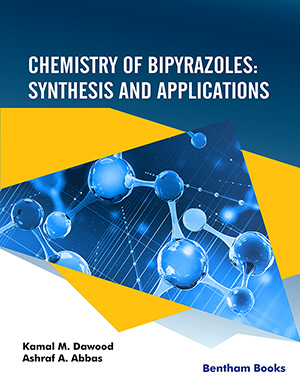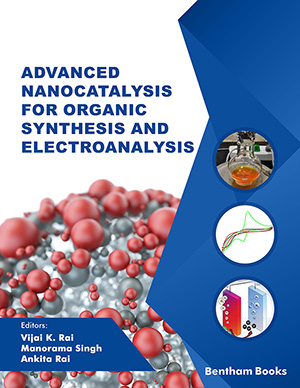
Abstract
The study aimed at a novel catalytic eco-friendly one-pot reaction for the synthesis of some new thiosemicarbazone and N-thiocarbamoyl pyrazole derivatives. The prepared and characterized silica-supported zinc chloride (ZnCl2/SiO2) catalyst has been presented for promoting the one-pot reaction between isothiocyanates (1 mmol), hydrazine (1.2 mmol) and 1,3- dicarbonyl (1 mmol) compounds under solvent-free conditions. The identification data explained that the thiosemicarbazones products were obtained in the case of using ethyl acetoacetate as an example of 1,3-dicarbonyl compounds and N-thiocarbamoyl pyrazole derivatives products were obtained in the case of using acetylacetone as an example of 1,3- dicarbonyl compounds. The presented catalyst silica-zinc chloride has been considered an eco-friendly and recyclable catalyst compared to the other reported catalyst. The biological activity of the synthesized compounds targeting the bacterial cell wall was predicted by the molecular docking as an undecaprenyl pyrophosphate synthase (UppS) inhibitor. Antioxidant data revealed the compounds 2a, 3d, 3e, 3f, 3g, 3h, and 3j to be promising antioxidant agents compared to ascorbic acid as a reference molecule.
Keywords: One-pot, isothiocyanate, thiosemicarbazones, pyrazoles, molecular docking, antioxidant, antibacterial.
Current Organic Chemistry
Title:ZnCl2/SiO2 as a New Catalyst for the Eco-Friendly Synthesis of N-Thiocarbamoyl Pyrazoles and Thiosemicarbazones with Antioxidant and Molecular Docking Evaluation as (UppS) Inhibitor
Volume: 25 Issue: 17
Author(s): Noha Shaker, Ezz Mohamed Kandil, Yasmen Osama*, Tamer Kamal Khatab and Mohamed E. Khalifa
Affiliation:
- Chemistry Department, Faculty of Science, Mansoura University, Mansoura,Egypt
Keywords: One-pot, isothiocyanate, thiosemicarbazones, pyrazoles, molecular docking, antioxidant, antibacterial.
Abstract: The study aimed at a novel catalytic eco-friendly one-pot reaction for the synthesis of some new thiosemicarbazone and N-thiocarbamoyl pyrazole derivatives. The prepared and characterized silica-supported zinc chloride (ZnCl2/SiO2) catalyst has been presented for promoting the one-pot reaction between isothiocyanates (1 mmol), hydrazine (1.2 mmol) and 1,3- dicarbonyl (1 mmol) compounds under solvent-free conditions. The identification data explained that the thiosemicarbazones products were obtained in the case of using ethyl acetoacetate as an example of 1,3-dicarbonyl compounds and N-thiocarbamoyl pyrazole derivatives products were obtained in the case of using acetylacetone as an example of 1,3- dicarbonyl compounds. The presented catalyst silica-zinc chloride has been considered an eco-friendly and recyclable catalyst compared to the other reported catalyst. The biological activity of the synthesized compounds targeting the bacterial cell wall was predicted by the molecular docking as an undecaprenyl pyrophosphate synthase (UppS) inhibitor. Antioxidant data revealed the compounds 2a, 3d, 3e, 3f, 3g, 3h, and 3j to be promising antioxidant agents compared to ascorbic acid as a reference molecule.
Export Options
About this article
Cite this article as:
Shaker Noha, Kandil Mohamed Ezz , Osama Yasmen*, Khatab Kamal Tamer and Khalifa E. Mohamed, ZnCl2/SiO2 as a New Catalyst for the Eco-Friendly Synthesis of N-Thiocarbamoyl Pyrazoles and Thiosemicarbazones with Antioxidant and Molecular Docking Evaluation as (UppS) Inhibitor, Current Organic Chemistry 2021; 25 (17) . https://dx.doi.org/10.2174/1385272825666210809142341
| DOI https://dx.doi.org/10.2174/1385272825666210809142341 |
Print ISSN 1385-2728 |
| Publisher Name Bentham Science Publisher |
Online ISSN 1875-5348 |
Call for Papers in Thematic Issues
Advances of Heterocyclic Chemistry with Pesticide Activity
Global food safety and security will continue to be a global concern for the next 50 years and beyond. Plant diseases have had a significant impact on food safety and security throughout the entire food chain, from primary production to consumption. While conventional chemical pesticides have been traditionally used for ...read more
Carbohydrates conversion in biofuels and bioproducts
Biomass pretreatment, hydrolysis, and saccharification of carbohydrates, and sugars bioconversion in biofuels and bioproducts within a biorefinery framework. Carbohydrates derived from woody biomass, agricultural wastes, algae, sewage sludge, or any other lignocellulosic feedstock are included in this issue. Simulation, techno-economic analysis, and life cycle analysis of a biorefinery process are ...read more
Catalytic C-H bond activation as a tool for functionalization of heterocycles
The major topic is the functionalization of heterocycles through catalyzed C-H bond activation. The strategies based on C-H activation not only provide straightforward formation of C-C or C-X bonds but, more importantly, allow for the avoidance of pre-functionalization of one or two of the cross-coupling partners. The beneficial impact of ...read more
Cutting-edge technology for the development of electrochemical sensors
Electrochemistry based point of care diagnostics is a powerful tool which can revolutionize the current concept of personalize health care industry. There have been several efforts to amalgamate cutting edge technologies (nanotechnology, surface technology, anti-biofouling strategies) while developing assays. The success of each electrochemical sensor is very dependable upon how ...read more
Related Journals
 23
23
- Author Guidelines
- Graphical Abstracts
- Fabricating and Stating False Information
- Research Misconduct
- Post Publication Discussions and Corrections
- Publishing Ethics and Rectitude
- Increase Visibility of Your Article
- Archiving Policies
- Peer Review Workflow
- Order Your Article Before Print
- Promote Your Article
- Manuscript Transfer Facility
- Editorial Policies
- Allegations from Whistleblowers
- Announcements
Related Articles
-
General Principles for the Treatment of Non-Infectious Uveitis
Inflammation & Allergy - Drug Targets (Discontinued) Subject Index to Volume 9
Current Pharmaceutical Design Meet Our Editorial Board Member
Current Bioinformatics Recent Advances of Poly(ether-ether) and Poly(ether-ester) Block Copolymers in Biomedical Applications
Current Drug Metabolism Chalcones and Chromones in Copper-Catalyzed Azide–Alkyne Cycloadditions (CuAAC)
Current Organic Chemistry Targeting DNA Repair Systems in Antitubercular Drug Development
Current Medicinal Chemistry Virus-Associated Vasculitides
Current Immunology Reviews (Discontinued) Expression, Purification, Crystallization and Preliminary X-Ray Crystallographic Analysis of the Peptidoglycan Binding Region of the Ser/Thr Kinase PrkC from Staphylococcus aureus
Protein & Peptide Letters Bioluminescent Quantitation and Detection of Gene Expression During Infectious Disease
Combinatorial Chemistry & High Throughput Screening Editorial [Hot Topic: Structure Based Drug Design (Guest Editor: K.V. Radha Kishan)]
Current Protein & Peptide Science Integrating Virtual Screening and Combinatorial Chemistry for Accelerated Drug Discovery
Combinatorial Chemistry & High Throughput Screening NKT Cell Subsets Can Exert Opposing Effects in Autoimmunity, Tumor Surveillance and Inflammation
Current Immunology Reviews (Discontinued) Diabetes Mellitus or Tuberculosis: Which is the Greater Evil?
Current Respiratory Medicine Reviews Molecular Approach to Targeted Therapy for Multiple Sclerosis
CNS & Neurological Disorders - Drug Targets Real-time Polymerase Chain Reaction for Mycobacterium tuberculosis Meningitis is More Sensitive in Patients with HIV Co-Infection
Current HIV Research Molecular Docking and Dynamics Simulation of Vibrio anguillarum Aspartate Semialdehyde Dehydrogenase with Natural Product Caulerpin
Letters in Drug Design & Discovery Bacterial Polyphosphate Kinases Revisited: Role in Pathogenesis and Therapeutic Potential
Current Drug Targets Recent Advances in the Diagnosis and Therapy of Primary Adrenal Insufficiency
Current Medicinal Chemistry - Immunology, Endocrine & Metabolic Agents Effects of Renal Replacement Therapy on Antimicrobial Therapy
Current Clinical Pharmacology Drug-lead Anti-tuberculosis Phytochemicals: A Systematic Review
Current Topics in Medicinal Chemistry

























